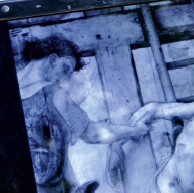
Doutoramento em História da Arte
Riverine Fortress city of Mahasthan in Deltaic Bengal: In search for the traditional settlement pattern of ancient cities

Orientação: Filipe Themudo Barata & José Alberto Machado
Bengal had passed through enormous experiences of socio‐cultural development, economical stabilities, advancement in literature and arts. During the reign of Buddhist, Hindu and Sultanate Bengal the society was cherished and enriched with full of values and cultural amalgamation. Co‐existence in the society evolved up and people started occupying time in trade‐transaction and society reformation. The ‘rebirth’ of the Bengali cultural consistency took a way forward to immense possible trails. To remain retain established and to protect the territory from external forces as well as the enemies, the ancient heroes had prepared themselves, besides invented with strong capability to reinforce fortified territory or the fortress city. The historic city planning implanted with different characteristics, and prolonged with variations in this delta land of Bengal. Ancient Bengal was focused with their settlement pattern by the bank of the river or by the watery sources. Settlement in the ancient time used to develop centering a religious structure. Eventually; it is the popular chronology for deriving a hamlet or a town. For the Buddhist era, religious community, bazaar and the maritime route came to focus with the mixture of various people and the nation. Simply, it was no exception for the case of the delta land Bengal, although this mainland is curved and chiseled with cress cross river networks; the ancient heroes contributed outposts for territorial protection and thoroughly generated the pattern of settlement. Mega structures, infrastructures and public welfare architecture were becoming the notion of the domain. That river fort architecture and the settlement patterns had the strategic and morphological characteristics, which got different from other purpose built forts, nonetheless‐was in consistence with the local city context. Bengali riverine fortress cities experienced lots of local and traditional influences only for being the river fort and their settlement around it, stating from the component, elements of forts and formal profile of the river. So, undoubtedly Bengal conceived unique kind of riverine oriented fortress settlement pattern, which has distinct typescripts. Even in the case of this fort formation the ancient Buddhist administrators had some strategic planning, morphology for spread city beyond the fort wall. The objective of the research is firstly to identify and to analyse the morphology of the ancient fortress cities1 and settlements in terms of their defence strategies and river fort architecture of Bengal. Secondly the context and the planning organization and positioning the sites for fortification addressing pictographic and conjectural restoration2 includes ancient city formation through river‐fort architecture in Bengal. The ancient settlement and architecture, dated back 8th Century AD of a specific site of MAHASTHAN would be the intensive area of the research, its memory, space, ‘sense of place’ and the traditional spatial pattern would be the intensive area of the study that would remind flexible towards regional conditions and building tradition as happened in riverine ancient Bengal. Lastly the study will explore the image (conjectural restoration) of the scale of the city, space, function and cultural longing of the neighbourhood pattern of ancient riverine settlement, through the critical literature reviewing, progressive archaeological excavation and by the referencing of historic pictographic information. The study will explore for meaning of ancient settlements in the subcontinent and its transformation in Bengal with a focus on defence strategies and its physical manifestation as well as the Digital Heritage phenomenon.
Keywords: ancient city, Medieval city, morphology, settlement pattern, cultural space, traditional spatial pattern, cultural heritage, memory of place, diagram, sketches, images of city, river fort of Bengal, maritime course, riverine city, conjectural restoration, pictographic information, neo‐visual statements’ neo‐visual statements, Digital Heritage
1 Buddhist period: Classical Period of Ancient Bengal (late 7th till 12th Century AD)
2 The restoration of a part of a text that is unreadable or completely absent in the original manuscript, which a researcher introduces into a text in the course of a scholarly description. The reconstruction of a text is based on historical, linguistic, and paleographic data. The use of certain textual elements is assumed to be systematic throughout a manuscript, for example, uniform makeup and consistency in orthography and in the use of words, syntactic forms, and expressions. Reconstruction is also possible on the basis of more general




